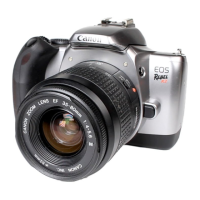
Do you have a question about the Canon 9113a014 - EOS Rebel K2 SLR Camera and is the answer not in the manual?
| Camera Type | SLR |
|---|---|
| Film Format | 35mm |
| Lens Mount | Canon EF |
| Exposure Modes | Program AE, Shutter-Priority AE, Aperture-Priority AE, Manual |
| Metering | Evaluative, Partial, Center-weighted average |
| Film Transport | Automatic |
| Built-in Flash | Yes |
| Flash Sync Speed | 1/90 sec |
| Shutter Speed | 30 to 1/2000 sec |
| Focusing | TTL phase detection |
| Viewfinder Type | Pentamirror |
| Power Source | 2 x CR123A or 2 x DL123A batteries |
Guide to inserting CR2 lithium batteries into the camera body.
How to check the camera's battery status and indicators.
Instructions for securely attaching and removing camera lenses.
Explanation of the two-stage operation of the shutter button.
Step-by-step process for loading and unloading 35mm film.
Procedure for rewinding film before the end of the roll.
Using the camera in fully automatic mode for point-and-shoot simplicity.
How the built-in flash illuminates subjects for improved autofocus.
Using the Portrait mode for blurred backgrounds and subject emphasis.
Using the Landscape mode for wide scenic views and enhanced depth.
Using the Close-up mode for detailed shots of small subjects.
Using the Sports mode to freeze fast-moving action.
Using Night Portrait mode for low-light shots with flash and slow sync.
Disabling the flash for situations where it is not needed.
How to activate and use the red-eye reduction feature.
Using the self-timer for delayed picture taking.
Operating the camera remotely using an optional wireless controller.
Attaching the eyepiece cover to prevent stray light during shooting.
Imprinting the date or time on photographs (DATE Model only).
How to choose among the camera's autofocus points for focusing.
Method to lock focus on a subject and recompose the shot.
Steps to take when the autofocus system cannot achieve focus.
Choosing between single-frame and continuous shooting modes.
Explanation of the different exposure metering modes available.
Using Program AE mode for general-purpose, easy picture-taking.
Setting shutter speed and letting the camera adjust aperture for exposure.
Setting aperture and letting the camera adjust shutter speed for exposure.
Manually setting both shutter speed and aperture for complete exposure control.
Achieving automatic wide depth of field for group photos and landscapes.
Adjusting exposure settings to make pictures lighter or darker.
Taking multiple shots with automatic exposure variations.
Locking exposure settings independently of focusing.
Using the shutter for long exposures, especially in low light.
Exposing multiple images on a single film frame.
Manually setting the camera's ISO film speed.
Guide to operating the camera's built-in flash in different modes.
Explanation of common symbols used in the manual.
Guidelines for maintaining and storing the camera to prevent damage.
Information on how LCD displays perform under different temperature conditions.
Precautions and guidelines for using camera batteries safely.
Understanding the impact of low battery levels on camera functions.
Instructions for cleaning and protecting lens electrical contacts.
Identification and function of the camera's Mode Dial.
Location and function of the camera's shutter button.
Location of the sensor for remote control operation.
Location of the camera grip and battery compartment.
Location and function of the viewfinder eyepiece.
Location and function of the camera's LCD panel.
Location of the button used for mid-roll film rewind.
Detailed explanation of icons and indicators on the LCD panel.
Details on the autofocus points displayed in the viewfinder.
How the exposure level is indicated in the viewfinder.
Solutions for when the camera's LCD panel shows no display.
Causes and solutions for blurry images, including camera shake.
Troubleshooting steps when the shutter button fails to operate.
Addressing issues related to the low battery warning indicator.
Overview of the camera's type, media, size, and lens compatibility.
Details on viewfinder coverage, magnification, and autofocus capabilities.
Information on metering modes, exposure compensation, and ISO settings.
Details on shutter speeds, flash types, and ranges.